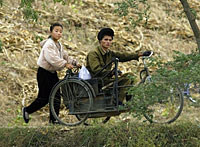




“Initially, one couldn’t see any disabled people in North Korea, and when we said we’d be sending them wheelchairs, they didn’t know exactly what we were talking about,” said Kim Hae Young, a missionary with the Los Angeles-based charity Shalom Disability Ministries.
“But [they] appeared to be quite happy to receive free assistance. However, the situation appears to have changed,” Kim told RFA’s Korean service.
Long rejected and marginalized by a regime that has only recently begun to acknowledge their existence, disabled North Koreans live under effective house arrest and are routinely expelled from the capital, Pyongyang, according to reports from defectors and aid groups in recent years.
Defectors living overseas have described a society that routinely uses derogatory language about the disabled, and an almost total lack of rehabilitation facilities or social services for them.
Kim agreed. “A while ago, motor disabled people in North Korea used to make their own wheelchairs out of wood. Back then, I could only see them from a distance, riding their makeshift wheelchairs, while everybody around was refusing to admit their existence.”
Disabled people in North Korea used to make their own wheelchairs out of wood. Back then, I could see them only from a distance, riding their makeshift wheelchairs, while everybody around was refusing to admit their existence.
“However,” she added, “that perception of the disabled is changing.” According to Kim, North Korea is even beginning to consider welfare for the disabled.
“Rehabilitation centers for the disabled are beginning to appear in North Korea, together with facilities for the elderly,” she told reporter Wonhee Lee.
“When the North Korean authorities build a rehabilitation center, religious groups such as the Shalom Disability Ministries engage in re-construction to improve these facilities, and also bring in the much needed physical therapy and rehabilitation equipment.”
Shalom Ministries’ Moses Park said the North Korean Federation for the Protection of the Disabled looked very favorably on the supply of wheelchairs by the group, even submitting requests for the necessary number of wheelchairs.
“Assistance for people with disabilities is now part of social welfare policy in North Korea, and the officials of the North Korean Federation for the Protection of the Disabled have no choice but to accept the assistance that we provide,” Park said.
Requests were now pouring in for crutches, blind canes and medical walkers, and the group had also shipped handcycles for paraplegics, polio patients, traffic accident victims and wounded former soldiers.
“Sooner rather than later, we expect to receive another request from the North Koreans,” Park added.
Kim said the political climate appeared to have changed around the issue of the disabled, making the subject more accessible in mainstream North Korean society.
The U.S. State Department’s 2006 country report on human rights in North Korea said that traditional social norms condone discrimination against persons with physical disabilities.
“Although veterans with disabilities were treated well, other persons with physical and mental disabilities have been sent out of Pyongyang into internal exile,” the report said.
However, the government passed a law in 2003 on the protection of persons with disabilities.
The World Association of Milal, an international disability NGO, estimates that 3.4 percent of North Koreans are living with some form of disability, with around 64 percent of those living in urban areas.
Original reporting in Korean by Wonhee Lee, Lee Aeran, Sung Woo Park, Naeri Kim, Changyoon Lee, Sookyung Lee, and Myeong Hwa Jang. Korean service director: Kwang-chool Lee. Translated and researched by Grigore Scarlatoiu. Written for the Web in English by Luisetta Mudie. Edited by Sarah Jackson-Han.